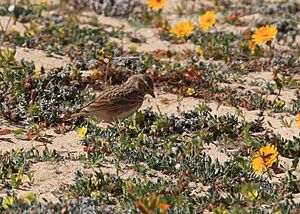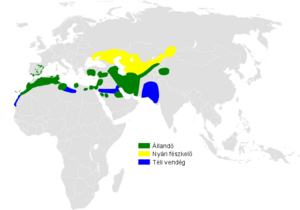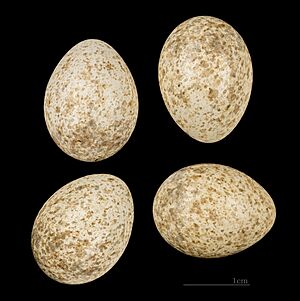Mediterranean short-toed lark facts for kids
Quick facts for kids Mediterranean short-toed lark |
|
|---|---|
 |
|
| On Fuerteventura, Canary Islands, Spain | |
| Conservation status | |
| Scientific classification | |
| Genus: |
Alaudala
|
| Species: |
rufescens
|
 |
|
| Range includes that of A. heinei | |
| Synonyms | |
|
|
The Mediterranean short-toed lark (Alaudala rufescens) is a small passerine bird. Passerine birds are also known as "perching birds" and include more than half of all bird species. This lark lives in and around the Mediterranean Basin. It is a common bird found in many places. Its range stretches from the Canary Islands in the west, north to the Iberian Peninsula, and east across North Africa to parts of the Middle East. The International Union for Conservation of Nature says this bird is a "least concern" species. This means it is not currently at risk of disappearing.
This bird was once thought to include populations from Central Asia. When combined, these birds were called the lesser short-toed lark. However, a study in 2020 found that the Mediterranean and Central Asian birds are actually two different species. A. rufescens is now the Mediterranean short-toed lark. The Central Asian one is now called the Turkestan short-toed lark (A. heinei). It can be a bit confusing because Hume's short-toed lark is also sometimes called the lesser short-toed lark.
Contents
About the Mediterranean Short-toed Lark
The Mediterranean short-toed lark was first described as part of the Alauda genus. The name Alaudala means "small lark." The word rufescens comes from Latin and means "reddish." This refers to the bird's reddish-brown colors.
What's in a Name?
This bird has had a few different names over time. Some of its other names include the common short-toed lark, grey lark, rufous short-toed lark, and simply short-toed lark. Some scientists used to think that the Athi short-toed lark, Asian short-toed lark, and Somali short-toed lark were all types of the lesser short-toed lark.
In 2020, a scientific study looked closely at the DNA of these larks. This study helped scientists understand how the different types of larks are related. It showed that the Mediterranean short-toed lark and the Asian short-toed lark, as they were known, were not single groups. This led to the decision to split the Mediterranean and Central Asian populations into two separate species.
Different Types of Mediterranean Short-toed Larks
There are five recognized types, or subspecies, of the Mediterranean short-toed lark:
- A. r. rufescens - Found on Tenerife in the western Canary Islands.
- A. r. polatzeki - Lives in the eastern Canary Islands.
- A. r. apetzii - Found in eastern and southern Iberian Peninsula (Spain and Portugal).
- A. r. minor - Lives from Morocco to north-western Egypt. It also ranges from southern Turkey to the Sinai Peninsula and eastern Iraq.
- A. r. nicolli - Found in the Nile Delta in northern Egypt.
Four other subspecies that were once part of A. rufescens are now part of the Turkestan short-toed lark (A. heinei).
What Does it Look Like?
The Mediterranean short-toed lark is similar in size to the greater short-toed lark. However, it usually looks a bit duller. It also has more streaks on its chest. This bird grows to be about 13 to 14 centimeters (5 to 5.5 inches) long. Male and female birds look very similar.
The color of these larks can change depending on where they live. So, color isn't the best way to tell them apart. They are generally grayish-brown with dark streaks on their back. Their underside is white. They have a pale stripe above their eye and a short, thick beak.
It's important to look closely to tell this bird apart from other larks in the Calandrella group. This species does not have the dark patches on its neck that the greater short-toed lark has. It has fine streaks across its chest. Its beak and head shape are also different. This lark has a shorter, less cone-shaped beak and a rounder, smaller head. Its song is also richer and more varied than its relatives.
Where Does it Live?
The Mediterranean short-toed lark breeds in Spain and North Africa. It also breeds in Turkey and eastwards across the dry lands of central Asia to Mongolia and China. Many of these bird groups, including those in Spain and Africa, do not migrate. This means they stay in the same place all year. However, some Asian birds from the northern parts of their breeding range fly south for the winter. This species is very rarely seen in northern and western Europe.
Life and Habits
This bird prefers dry, open areas. It likes even drier and barer ground than the greater short-toed lark. It builds its nest on the ground. The female bird usually lays two or three eggs.
What Does it Eat?
The Mediterranean short-toed lark eats mostly seeds. During the breeding season, it also eats a lot of insects.



